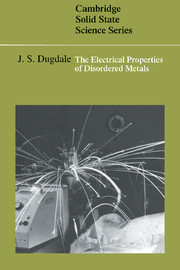Book contents
- Frontmatter
- Contents
- Preface
- 1 Context and content
- 2 Production and structure of metallic glasses
- 3 Electron transport in metals: introduction to conventional theory
- 4 Scattering
- 5 Simple liquid metals: Ziman theory
- 6 Phonons in disordered systems
- 7 Interactions and quasi-particles
- 8 Transition metals and alloys
- 9 The Hall coefficient of metallic glasses
- 10 Magnetoresistance
- 11 Electrical conductivity of metallic glasses: weak localisation
- 12 The interaction effect or Coulomb anomaly
- 13 The effect of the Coulomb interaction on conductivity
- 14 Influence of a magnetic field on the enhanced interaction effect
- 15 The thermopower of metals and alloys
- 16 Comparison with experiment
- Appendices
- Notes
- References
- Index
3 - Electron transport in metals: introduction to conventional theory
Published online by Cambridge University Press: 21 January 2010
- Frontmatter
- Contents
- Preface
- 1 Context and content
- 2 Production and structure of metallic glasses
- 3 Electron transport in metals: introduction to conventional theory
- 4 Scattering
- 5 Simple liquid metals: Ziman theory
- 6 Phonons in disordered systems
- 7 Interactions and quasi-particles
- 8 Transition metals and alloys
- 9 The Hall coefficient of metallic glasses
- 10 Magnetoresistance
- 11 Electrical conductivity of metallic glasses: weak localisation
- 12 The interaction effect or Coulomb anomaly
- 13 The effect of the Coulomb interaction on conductivity
- 14 Influence of a magnetic field on the enhanced interaction effect
- 15 The thermopower of metals and alloys
- 16 Comparison with experiment
- Appendices
- Notes
- References
- Index
Summary
The source of electrical resistance
In trying to understand the electron transport properties of metallic glasses – properties such as electrical conductivity, Hall coefficient and thermopower – we shall start by using conventional theories that have been successful in accounting for the corresponding properties in crystalline metals and alloys and see how far these theories are successful in describing the properties of metallic glasses. I will explain what I mean by ‘conventional’ theories as we go along.
The starting point in understanding the electrical conductivity, σ, or resistivity, ρ(= 1/σ) of metals is the fact that the de Broglie waves which represent the conduction electrons can propagate without attenuation through a perfectly periodic lattice, such as that formed by the positive ions of an ideally pure and perfect crystalline metal at absolute zero. There is thus no electrical resistivity. More strictly, the electrons are scattered by the ions but only coherently as in Bragg reflections from the lattice planes. Such coherent scattering alters the way the electrons respond to applied electric and magnetic fields but does not cause electrical resistance. Such resistance comes about through random, incoherent scattering of the electron waves; this occurs only when the periodicity of the lattice and its associated potential is upset.
This means that, if you now add to your pure and perfect crystal chemical impurities randomly distributed, they will disturb the perfect periodicity and cause resistance to the flow of the electric current. Likewise, physical imperfections such as vacancies, dislocations or grain boundaries will produce electrical resistance even at the absolute zero. These imperfections and chemical impurities upset the perfect periodicity and so scatter the electrons that carry the electric current.
- Type
- Chapter
- Information
- The Electrical Properties of Disordered Metals , pp. 20 - 33Publisher: Cambridge University PressPrint publication year: 1995

